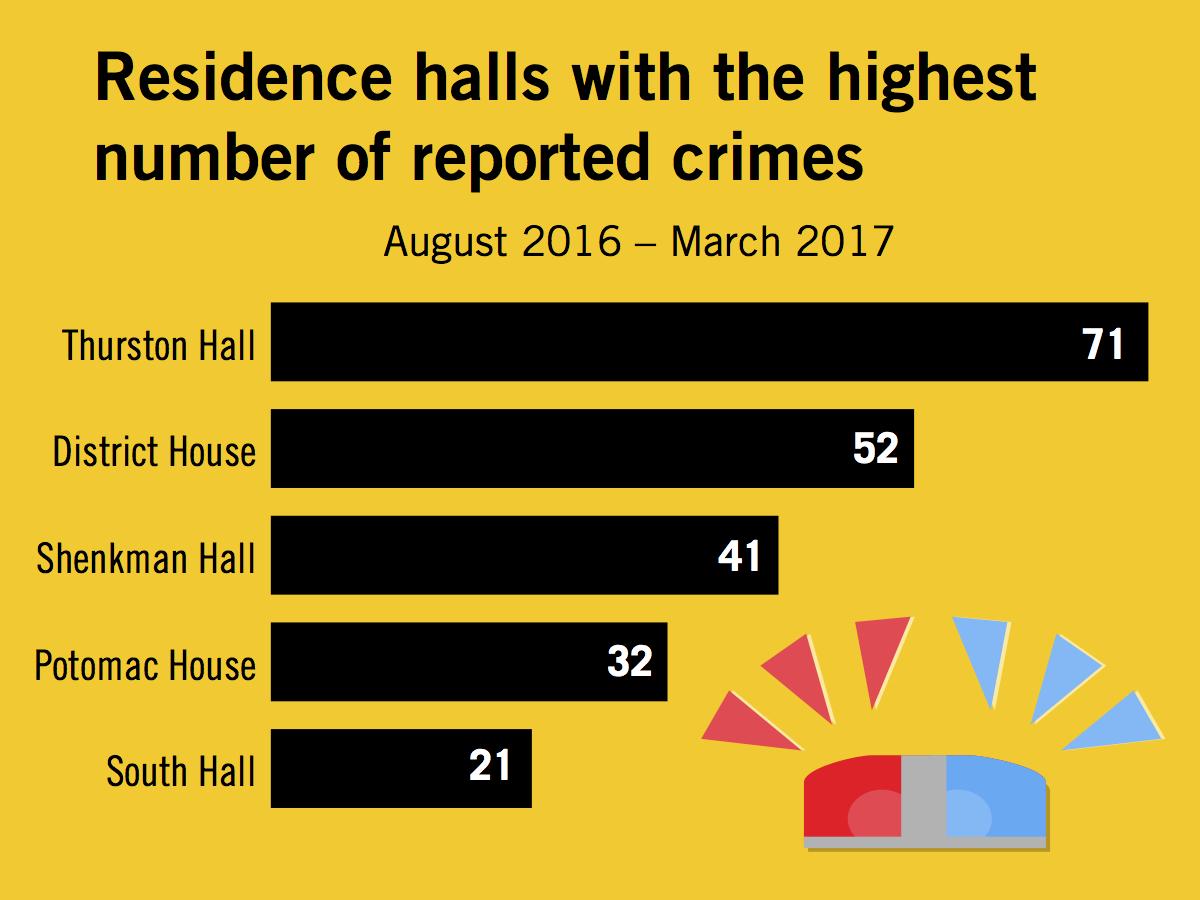
Yonah Bromberg Gaber | Graphics Editor
Source: Office of Institutional Research & Planning
Only eight months after opening, District House is already one of the most crime-prone residence halls on campus.
District House, which opened to students and the public in August, has amassed the second-largest number of reported crimes in residence halls with 52 crime reports this academic year, according to the GW crime log. Experts attributed the high volume of reports to the building’s large student population and its bustling basement area that’s open to the public, providing opportunities for crimes.
District House trails only Thurston Hall, which has racked up 71 crime reports since August, according to the crime log.
District House also has the second-highest residence hall crime rate with 0.061 crime reports per student resident this academic year, according to the crime log. Thurston Hall remains the most crime-prone residence hall with a rate of 0.064 reports per resident.
Darrell Darnell, the senior associate vice president for safety and security, said University and Metropolitan police department officers patrol sidewalks and streets to prevent crime and create visibility.
“We analyze a variety of factors when determining its safety and security staffing and patrols within all buildings, including reviewing crime trends and staffing resources and readjust as necessary,” Darnell said in an email.
District House, which is made up of three previously separate residence halls, is home to more than 850 students on 12 floors of doubles, quads and affinities. Thurston Hall houses 1,116 students, while Shenkman Hall holds 730 students. No other residence hall on campus has more than 500 beds per living space, according to the GW Housing website.
There have been 41 liquor law violations in Thurston Hall since the beginning of the school year, compared to 18 liquor violations in District House. Sixteen thefts have been reported in District House and six in Thurston since August.
Several prominent crimes have been reported to UPD in District House in its first academic year. In December, a student kicked and shattered the entrance door to the building, and a subject allegedly stole a MacBook and sunglasses among other items from the basement area last month.
Experts said a variety of factors – like the age of the students who live in a building and how closely they are monitored – affect how susceptible to crime one residence hall is compared to another.
Sue Riseling, the executive director of the International Association for Campus Law Enforcement Administrators, said people can feel anonymous in a large residence hall with more than six floors, and are less likely to respect others’ property or intervene if they witness criminal activity.
“It’s very difficult to know who belongs and who doesn’t, and who is an invited guest versus who just found their way in,” Riseling, who is also the former Chief of Police at University of Wisconsin-Madison, said.
Unlike in District House, UPD officers are stationed in the lobby of Thurston Hall 24 hours a day to monitor visitors. Tap access is required to enter the building, whereas the public does not need a GWorld card to access the basement area in District House during business hours.
Chris McGoey, the president of McGoey’s Security Consulting, said places where large groups of people congregate, like a food court, will likely be more conflict-prone than less crowded parts of a campus.
District House has six dining vendors that have opened gradually since December within the building.
“It’s a place for people to hang out, and you might have disagreements between groups who have issues and this could be the place where they run into each other,” he said.
Although added security can deter criminal activity near a residence hall, it does not affect incidents inside the building, McGoey said.
“If the crime rate is caused by the people that live there, then you could posts security guards everywhere – you could put a moat with alligators around it, but you’re still have crime because the people living there are causing the crime,” he said.




